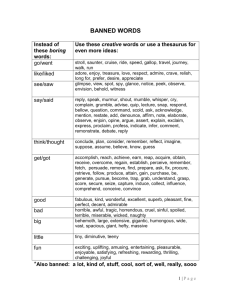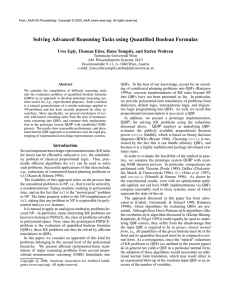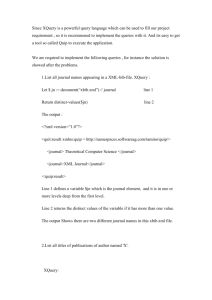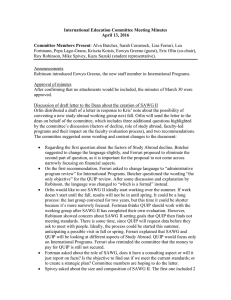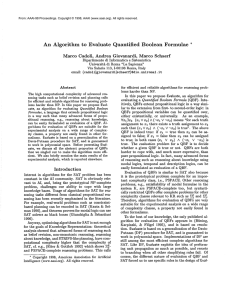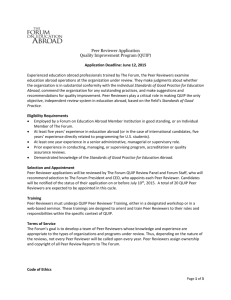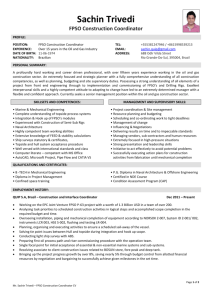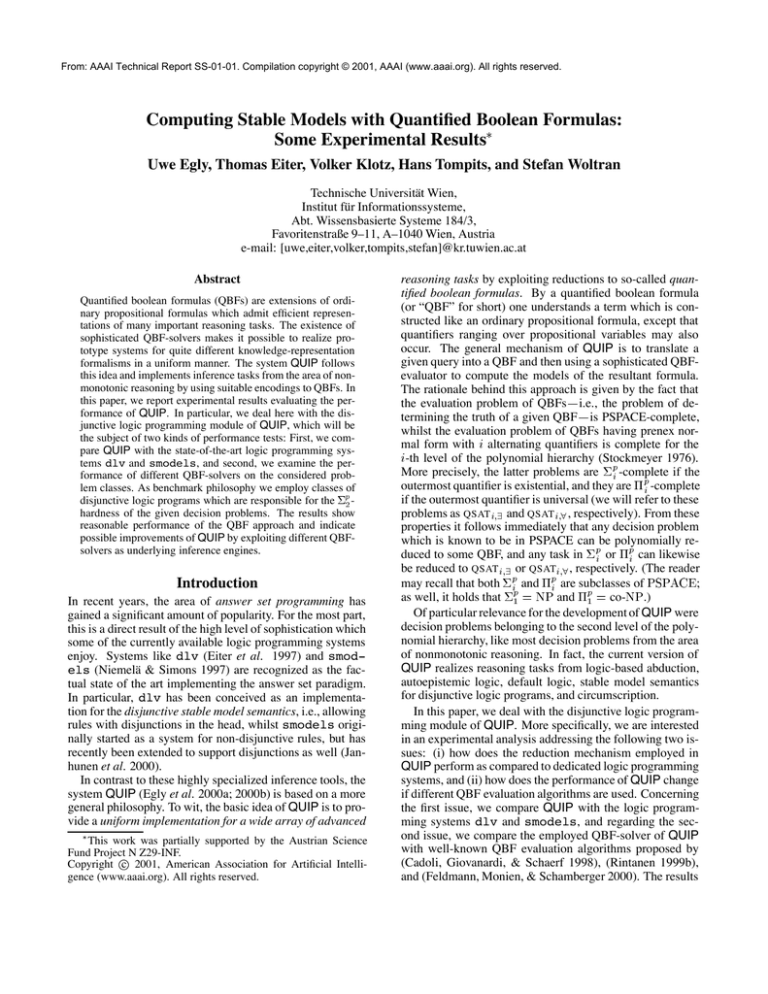
From: AAAI Technical Report SS-01-01. Compilation copyright © 2001, AAAI (www.aaai.org). All rights reserved.
Computing Stable Models with Quantified Boolean Formulas:
Some Experimental Results
Uwe Egly, Thomas Eiter, Volker Klotz, Hans Tompits, and Stefan Woltran
Technische Universität Wien,
Institut für Informationssysteme,
Abt. Wissensbasierte Systeme 184/3,
Favoritenstraße 9–11, A–1040 Wien, Austria
e-mail: [uwe,eiter,volker,tompits,stefan]@kr.tuwien.ac.at
Abstract
Quantified boolean formulas (QBFs) are extensions of ordinary propositional formulas which admit efficient representations of many important reasoning tasks. The existence of
sophisticated QBF-solvers makes it possible to realize prototype systems for quite different knowledge-representation
formalisms in a uniform manner. The system QUIP follows
this idea and implements inference tasks from the area of nonmonotonic reasoning by using suitable encodings to QBFs. In
this paper, we report experimental results evaluating the performance of QUIP. In particular, we deal here with the disjunctive logic programming module of QUIP, which will be
the subject of two kinds of performance tests: First, we compare QUIP with the state-of-the-art logic programming systems dlv and smodels, and second, we examine the performance of different QBF-solvers on the considered problem classes. As benchmark philosophy we employ classes of
disjunctive logic programs which are responsible for the ¾ hardness of the given decision problems. The results show
reasonable performance of the QBF approach and indicate
possible improvements of QUIP by exploiting different QBFsolvers as underlying inference engines.
Introduction
In recent years, the area of answer set programming has
gained a significant amount of popularity. For the most part,
this is a direct result of the high level of sophistication which
some of the currently available logic programming systems
enjoy. Systems like dlv (Eiter et al. 1997) and smodels (Niemelä & Simons 1997) are recognized as the factual state of the art implementing the answer set paradigm.
In particular, dlv has been conceived as an implementation for the disjunctive stable model semantics, i.e., allowing
rules with disjunctions in the head, whilst smodels originally started as a system for non-disjunctive rules, but has
recently been extended to support disjunctions as well (Janhunen et al. 2000).
In contrast to these highly specialized inference tools, the
system QUIP (Egly et al. 2000a; 2000b) is based on a more
general philosophy. To wit, the basic idea of QUIP is to provide a uniform implementation for a wide array of advanced
This work was partially supported by the Austrian Science
Fund Project N Z29-INF.
Copyright c 2001, American Association for Artificial Intelligence (www.aaai.org). All rights reserved.
­
reasoning tasks by exploiting reductions to so-called quantified boolean formulas. By a quantified boolean formula
(or “QBF” for short) one understands a term which is constructed like an ordinary propositional formula, except that
quantifiers ranging over propositional variables may also
occur. The general mechanism of QUIP is to translate a
given query into a QBF and then using a sophisticated QBFevaluator to compute the models of the resultant formula.
The rationale behind this approach is given by the fact that
the evaluation problem of QBFs—i.e., the problem of determining the truth of a given QBF—is PSPACE-complete,
whilst the evaluation problem of QBFs having prenex normal form with alternating quantifiers is complete for the
-th level of the polynomial hierarchy (Stockmeyer 1976).
More precisely, the latter problems are -complete if the
outermost quantifier is existential, and they are -complete
if the outermost quantifier is universal (we will refer to these
problems as QSAT and QSAT , respectively). From these
properties it follows immediately that any decision problem
which is known to be in PSPACE can be polynomially reduced to some QBF, and any task in or can likewise
be reduced to QSAT or QSAT , respectively. (The reader
may recall that both and are subclasses of ;
as well, it holds that and co-.)
Of particular relevance for the development of QUIP were
decision problems belonging to the second level of the polynomial hierarchy, like most decision problems from the area
of nonmonotonic reasoning. In fact, the current version of
QUIP realizes reasoning tasks from logic-based abduction,
autoepistemic logic, default logic, stable model semantics
for disjunctive logic programs, and circumscription.
In this paper, we deal with the disjunctive logic programming module of QUIP. More specifically, we are interested
in an experimental analysis addressing the following two issues: (i) how does the reduction mechanism employed in
QUIP perform as compared to dedicated logic programming
systems, and (ii) how does the performance of QUIP change
if different QBF evaluation algorithms are used. Concerning
the first issue, we compare QUIP with the logic programming systems dlv and smodels, and regarding the second issue, we compare the employed QBF-solver of QUIP
with well-known QBF evaluation algorithms proposed by
(Cadoli, Giovanardi, & Schaerf 1998), (Rintanen 1999b),
and (Feldmann, Monien, & Schamberger 2000). The results
show, on the one hand, that the QBF approach is surprisingly competitive on certain problem instances compared to
dlv and smodels, and, on the other hand, that alternative
QBF algorithms enable an increased performance on examples where the currently employed QBF-solver of QUIP is
inefficient.
An important point in every evaluation test concerns the
question which problem classes should be used as benchmarks in order to obtain indicative results. Since currently
there are no generally accepted benchmarks for nonmonotonic theorem provers, different approaches have been chosen in the literature. Often, experimenters choose problems which are viewed as “natural” or “interesting” in
terms of real-life applications, but it is not always clear
whether these problems are really “hard” for the given formalism. An approach for generating benchmarks for nonmonotonic theorem provers has been proposed by the wellknown TheoryBase system (Cholewinski et al. 1995), originally developed as a test-bed for the default reasoning system DeReS (Cholewinski, Marek, & Truszczyński 1996).
TheoryBase provides encodings of various graph problems
in terms of default theories or equivalent logic programs.
However, the generated problems are at most NP-hard (or
co-NP-hard, depending on the reasoning task), and thus do
not take full advantage of the expressibility supported by the
majority of the nonmonotonic reasoning formalisms.
For the present purpose, we adopt a straightforward
method how -hard benchmark problems for propositional
nonmonotonic reasoning formalisms can be generated, following a similar test procedure used to construct benchmarks for theorem provers implementing various propositional modal logics (Massacci 1999). The idea is to use the
class of problems establishing the -hardness of a given
reasoning task. Usually, -hardness of a nonmonotonic
formalism is demonstrated by constructing a (polynomial)
transformation mapping instances of QSAT into instances of the considered nonmonotonic decision problem, say NMP , such that is a yes-instance of QSAT iff
is a yes-instance of NMP. 1 Thus, in some sense, the
class of problems represents “worst-case” examples
for the problem NMP , provided hard instances of QSAT are generated. Moreover, these problems are easily scalable
by parameterizing different instances of QSAT .
The paper is organized as follows. The next section gives
background terminology and notation, as well as information on QUIP. Then, details on the performance tests are
presented. The paper concludes with a brief discussion.
Background
In what follows, we assume a propositional language generated by a finite set of propositional atoms using the standard sentential connectives , , , and . A quantified
boolean formula (QBF) is a formula which may additionally
1
¾
Observe that QUIP implements a given decision problem
¾ precisely in an inverse fashion: given an instance QUIP translates into an instance of QSAT¾
such that is a yes-instance of NMP iff is a yes-instance of
QSAT¾ .
NMP
of NMP ,
Ì
Ì
contain occurrences of quantifiers ranging over propositional atoms. Informally, a QBF of the form means
that for all truth-assignments of there is a truth-assignment
of such that is true. For instance, it is easily seen that
the QBF
evaluates to true. As noted in the Introduction, the evaluation problem of arbitrary QBFs is PSPACE-complete, and
the problems QSAT and QSAT are complete for and
, respectively.
A disjunctive logic program, , is a finite set of rules
where is a disjunction of atoms, is a conjunction of atoms, and is a conjunction of negated atoms.
Let denote the set of all atoms occurring in . A Herbrand
interpretation of is a stable model of (Gelfond & Lif
schitz 1988; Przymusinski 1991) if it is a minimal model
(with respect to set-inclusion) of the program resulting
from as follows: remove each rule such that for
some in , and remove from all remaining
rules ( is known as the Gelfond-Lifschitz reduction (Gelfond & Lifschitz 1988)).
The relevant reasoning tasks in the context of stable models are:
Given a disjunctive logic program , is there a stable
model of ?
Brave reasoning: Given a disjunctive logic program and some atom , is there a stable model of such that
?
Skeptical reasoning: Given a disjunctive logic program and some atom , does hold for all stable models of ?
Eiter and Gottlob (1995) showed that the first two tasks
are complete for , whilst the third task is complete for
. Thus, checking the existence of a stable model as well
as brave reasoning can be polynomially reduced to QSAT ,
and skeptical reasoning can be reduced to QSAT . In the
following, we briefly describe these transformations.
Let be a logic program, and let be the atoms occurring in . Furthermore, let be a set of new variables, and let denote the
result of replacing every occurrence of an atom in by
. Then, following from results shown in (Eiter & Gottlob
1997), existence of a stable model of can be expressed by
the QBF , where
and
represents the
conjunction of all rules in ;
takes care of
the Gelfond-Lifschitz reduction; and
is an abbreviation for .
filter
QBF
SOP
boole
int
protocol mapping
Figure 1: QUIP’s system architecture.
Observe that the premise in contains the atoms
from but not those from !
Brave inference of an atom from is expressed by
whilst skeptical inference of from is realized by
The QBFs discussed so far encode decision problems,
i.e., they return either yes or no. However, usually one is
more interested in the corresponding function problems returning the actual stable models responsible for a given yesanswer. This is easily achieved by simply dropping the outermost quantifier in the formulas above and computing
the respective truth-assignments. More precisely, the propositional models of the formula correspond to the stable
models of the program , and the propositional models of
give all stable models of containing the atom
, whilst the propositional models of yield
stable models not including .
All these reasoning tasks have been implemented in
QUIP. The overall architecture of QUIP is depicted in
Figure 1. QUIP consists of three parts, namely the filter program, the QBF-evaluator boole, and the interpreter int. The input filter translates the given problem
description (in our case, a disjunctive logic program and a
specified reasoning task) into the corresponding quantified
boolean formula, which is then sent to the QBF-evaluator
boole. The result of boole, usually a formula in disjunctive normal form (often called sum of products, SOP),
characterizes the truth-assignments of the QBF, and is interpreted by int. The latter part associates a meaningful interpretation to the formulas occurring in SOP and provides
an explanation in terms of the underlying problem instance
(e.g., a stable model). The QBF-evaluator boole is a publicly available propositional theorem prover based on binary
decision diagrams (BDDs), which can be downloaded from
the web (http://www.cs.cmu.edu/modelcheck/bdd.html).
Comparisons
In this section, we describe our employed test methodology
in detail and present the achieved results. First, we introduce the class of problems which are used as benchmarks
during the tests. Then, the comparison of QUIP with the
dedicated logic programming systems dlv and smodels
is described. Finally, the performance of different QBF evaluation algorithms on the considered benchmark problems is
analysed.
Benchmarks
As already argued in the Introduction, we use a class of
logic programs encoding the -complete problem QSAT of determining the truth of QBFs having prenex normal
form , where are lists of propositional variables comprising all variables of the propositional formula
. As is well-known (Wrathall 1976), the problem QSAT remains -hard if we consider QBFs where is
in disjunctive normal form such that each clause comprises
exactly three literals. Thus, the generated QBFs have the
following structure:
(1)
where
is the number of the existentially quantified variables;
is the number of the universally quantified variables;
is the number of clauses; and
or , where is some atom among
for and .
As shown by Eiter and Gottlob (1995), determining the
truth of a QBF of form (1) can be expressed by the
following disjunctive logic program , where ,
, and are new propositional variables:
are literals
,
not for for for The function maps literals to atoms as follows:
if for some if for some otherwise.
Programs of this form constitute the benchmark problems
used in our tests. It holds that has a stable model iff evaluates to true.
In order to generate QBFs which are hard for QSAT (and thus yielding hard programs ), some care is required. As has been pointed out by Gent and Walsh (1999),
sets of randomly generated QBFs tend to include an immoderately number of trivial instances and thus are not representative as basis for objective evaluation tests. As a consequence, we generate QBFs according to Model A, advocated
by Gent and Walsh (1999), to circumvent this problem. Actually, we adopt a dual variant of this model because the
original version has been introduced to deal with formulas
in conjunctive normal form, whereas we use here formulas
in disjunctive normal form. In this variant of Model A, every clause is supposed to contain at least two literals from
the set of universally quantified variables of the generated
QBF, and repetitions are discarded.
QUIP
dlv
running time [s]
2500
2000
1500
1000
QBFs versus Logic Programming Systems
The first test-set comprises comparisons between QUIP,
dlv, and smodels. All results have been achieved using
the problem of constructing the stable models of programs
generated as described above.
The specific details of the tests are as follows:
500
0
14
20
25
30
35
number k=(n+m) 40
45
We used dlv (release date 2000-04-05) and smodels v2.25.
All evaluations have been performed on an Alpha-server
equipped with two 500MHz Alpha-21264 processors,
1 Gigabyte of RAM, and a Linux 2.2.13-SMP kernel
(SuSE-Linux 6.3).
We generated QBFs according to Model A, with the number of distinct variables ranging from 20 to 48,
the number of existentially quantified variables ranging
from 4 to 18, and the number of clauses determined by
the factor , where was chosen 1.1, 1.3, 1.5, and
1.7. For each selected parameter setting, we took 30 samples and calculated the mean value. Time-out was set to
15000s, but was never reached during the experiments.
Results are given in Figures 2–7. Figures 2 and 3 contain diagrams depicting the running time of QUIP vs. dlv
and smodels, respectively, depending on the two parameters and , and with fixed factor . The graphs
reveal a strong dependence of the running time of QUIP on
the number of distinct variables. In contrast, the running
times of both dlv and smodels are more influenced by
the number of existentially quantified variables. Detailed
sections of these diagrams are given in Figures 4–7. More
specifically, Figure 4 contains the running times of all three
systems over the number of distinct variables, for different
values of and with held constant. Dually, Figure 5 depicts a similar scenario, but for different values of
and with held constant. These diagrams reiterate the behaviour observed above, namely that the running
time of QUIP depends strongly on the number of distinct
variables, but less on the number of existentially quantified variables, whereas dlv and smodels show a converse
behaviour. The latter two systems are also less influenced
by different values of (Figure 5), whilst QUIP shows a
stronger dependence on this factor.
Figures 6 and 7 contain the running times over the number
of existentially quantified variables. In particular, Figure 6
illustrates again the strong dependence of QUIP on but the
weak dependence on , and the converse behaviour for dlv
and smodels. Also interesting to note is the fact that, for
small values of , QUIP is outperformed by both dlv and
smodels, but wins over these systems as grows.
50 2
4
6
Figure 2: Results for QUIP and dlv with 8
10
16
18
12
number n
constant.
QUIP
smodels
running time [s]
2500
2000
1500
1000
500
0
14
20
25
30
35
number k=(n+m) 40
45
50 2
4
6
8
10
Figure 3: Results for QUIP and smodels with
constant.
16
18
12
number n
Overall, we can say that QUIP is quite capable to stand
against dedicated logic programming systems, at least on
certain instances of the considered problem class. For largersized problem instances, boole works less satisfactorily
and both dlv and smodels are more efficient. This specific problem domain is not detailed in the present diagrams
and will be the subject of the following set of evaluation
tests.
Comparison of Different QBF-Evaluators
The second category of tests was set out to compare boole
with the QBF-solvers Evaluate (Cadoli, Giovanardi, &
Schaerf 1998), qbf (Rintanen 1999b), and ssolve (Feldmann, Monien, & Schamberger 2000). Thus, in this case,
10000
n=18
1000
10000
QUIP
dlv
smodels
1000
running time [s]
running time [s]
k=48
100
n=4
10
n=18
1
n=10
n=10
0.1
100
k=48
k=40
k=32
10
k=32
1
0.1
n=4
0.01
0.01
20
25
30
35
40
45
50
number k=(n+m) of distinct variables
Figure 4: Results for different values of and stant.
4
6
8
10 12 14 16 18
number n of existentially quantified variables
con-
Figure 6: Results for different values of and stant.
con-
10000
10000
f=1.7
1000
1000
f=1.5
f=1.7
f=1.3
100
running time [s]
running time [s]
f=1.7
f=1.1
10
1
100
f=1.5
f=1.3
10
f=1.1
f=1.1
1
0.1
0.1
0.01
0.01
20
4
6
8
10 12 14 16 18
number n of existentially quantified variables
25
30
35
40
45
50
number k=(n+m) of distinct variables
Figure 5: Results for different values of and stant.
con-
we are only interested in the evaluation time of the reduced
QBFs (resulting from the programs according to the reduction described in the Background section) and not in the
overall processing time.
With the exception of boole, the considered tools do not
accept arbitrary QBFs, but require the input formula to be in
prenex conjunctive normal form. For these tools, the generated QBFs are translated into definitional normal form (Eder
1992; Plaisted & Greenbaum 1986). In contrast to the usual
normal form translation based on distributivity laws, the definitional normal form translation is structure preserving and
polynomial in the length of the input formula.
Another issue concerns the fact that the systems Evaluate and qbf cannot output the satisfying truth-assignments
of the free variables of a given (open) QBF, which, in our
approach, is a necessary prerequisite in order to construct
the corresponding stable models. Consequently, the present
tests perform only decision problems, i.e., checking whether
there is a stable model of a given program. As well, Evaluate, qbf, and ssolve are currently not available for
Alpha-processors, so the two-processor server employed in
Figure 7: Results for different values of and stant.
con-
the previous experiments could not be used here and we ran
the tests on a somewhat less powerful SUN workstation under Solaris.
The specific details of the tests are as follows:
We used boole, ssolve v4.5, Evaluate v1.0,
and qbf v1.0. The latter package was executed with
option -f, which leads to a better performance on the
considered QBFs.
The tests have been performed on a SUN ULTRA 60 with
256 MB RAM and SunOS 5.6.
The input QBFs are of the form , expressing the
existence of stable models of the program (cf. Background section), where is the class of benchmark programs generated as described previously. Accordingly,
the parameters , , , , and are to be understood as
before. This time, ranged from 10 to 150, ranged from
4 to 20, and ranged from 15 to 515; time-out and sample size are identical to the settings of the first test. In the
present case, however, time-out was reached during the
experiments and the results are displayed only for those
values which were not affected by instances reaching the
time-out.
Conclusion
In this paper, we considered the computation of stable models for disjunctive logic programs by means of a reduction
to quantified boolean formulas. We compared the realization of this approach with dedicated logic programming systems, and we also evaluated how different QBF-solvers behave on such QBFs. The class of problems used to perform
these tests have been chosen purely on a worst-case basis,
in accord with investigations to generate hard instances of
SAT (Selman, Mitchell, & Levesque 1996). The results of
our experiments demonstrate that the QBF approach is a viable tool for rapid prototyping applications. Also, different
QBF-packages can yield an increased performance for instances where the current BDD-based QBF-solver of QUIP
is inefficient. In fact, alternative QBF evaluation algorithms
can easily be incorporated within QUIP and substantiate one
2
One should observe that the parameters indicated in the diagrams reflect the number of variables of the original QBFs,
whereas the actually tested formulas involve much more variables
(which are introduced by the reductions and the normal form translation).
ssolve
Evaluate
qbf
boole
running time [s]
1000
100
10
1
0.1
5
10
15
20
25
30
35
factor f= (3 * t / k)
Figure 8: Results for different values of and constant.
, 10000
running time [s]
1000
100
10
1
0.1
4
6
8 10 12 14 16 18 20
number n of existentially quantified variables
Figure 9: Results for different values of and constant.
, 10000
1000
running time [s]
The results are depicted in Figures 8–10. Figure 8 displays the performance of all four systems in relation to varying values of the factor , holding both the number of total variables and the number of existentially quantified variables constant. Figure 9 depicts the running time for
different values of , with and constant (thus
representing graphs with ). Figure 10 gives the running time over the total number of variables with and constant.
The results of Figure 8 show that the running time of
boole grows strongly with increasing ; in fact, boole is
unable to compute any instances above due to memory overloading. On the other hand, ssolve, qbf, and
Evaluate display quite a different behaviour: they show a
typical phase transition pattern in the region of , representing an easy-hard-easy phenomenon well-documented
for SAT-problems. Figure 9 reveals that ssolve, qbf, and
Evaluate are like dlv and smodels strongly dependent on the number of existentially quantified variables,
whereas the graph for boole is more or less constant and
outperforms the other systems for large numbers of existentially quantified variables. On the other hand, Figure 10
shows (more directly than Figure 8) that boole cannot handle problems involving a large totality of variables. 2 This is
a well-known weakness of theorem provers based on binary
decision diagrams.
In any case, these experiments demonstrate quite clearly
that the algorithm ssolve (Feldmann, Monien, & Schamberger 2000) is superior to both qbf and Evaluate on the
considered problem class. Also, since boole has quite a
different behaviour than these QBF-solvers, the inclusion of
ssolve within the framework of QUIP (by, e.g., invoking
it in parallel with boole) will improve the overall performance on instances which are difficult to handle for boole.
10000
100
10
1
0.1
0.01
20 40 60 80 100 120 140
number k=(n+m) of distinct variables
Figure 10: Results for different values of
constant.
and
,
of the advantages of our framework. For instance, an ideal
candidate of such an extension of QUIP is the distributed
version of ssolve (Feldmann, Monien, & Schamberger
2000), which runs on PC-clusters yielding an even better
performance than the sequential version of ssolve considered in the present paper.
In general, the use of QBFs for knowledge representation purposes has been advocated in the literature (Cadoli,
Giovanardi, & Schaerf 1998; Rintanen 1999b), and, besides
the present system QUIP, applications to planning problems
have been realized (Rintanen 1999a).
Our experiments involving the different QBF-solvers
were based on a structure preserving normal form translation. Such normalization transformations have certain advantages compared to standard translations. For first-order
systems, they can yield, e.g., a nonelementary decrease of
proof length and search space (Egly 1996). Clearly, different such translations affect the overall performance of a
system; a deeper analysis of this issue in the context of the
present approach is left for future research. As a matter of
fact, we plan to investigate to what extent the mixed normal
form translation discussed by Boy de la Tour (1992) can be
useful within our framework.
Another point which warrants a more closer investigation concerns the phase transition patterns observed in the
present experiments. Such phenomena are well-known for
SAT-problems and have also been studied for QBFs (Gent &
Walsh 1999; Cadoli et al. 2000), but they clearly require a
more thorough analysis for the considered problem classes.
References
Boy de la Tour, T. 1992. An Optimality Result for
Clause Form Translation. Journal of Symbolic Computation 14(4):283–302.
Cadoli, M.; Giovanardi, A.; Giovanardi, M.; and Schaerf,
M. 2000. An Algorithm to Evaluate Quantified Boolean
Formulae and its Experimental Evaluation. Journal of Automated Reasoning. To appear.
Cadoli, M.; Giovanardi, A.; and Schaerf, M. 1998. An
Algorithm to Evaluate Quantified Boolean Formulae. In
Proc. AAAI-98, 262–267.
Cholewinski, P.; Marek, W.; Mikitiuk, A.; and
Truszczyǹski, M. 1995. Experimenting with Nonmonotonic Reasoning. In Proc. ICLP-95, 267–282.
Cholewinski, P.; Marek, W.; and Truszczyński, M. 1996.
Default Reasoning System DeReS. In Proc. KR-96, 518–
528.
Eder, E. 1992. Relative Complexities of First-Order Calculi. Artificial Intelligence. Vieweg Verlag.
Egly, U.; Eiter, T.; Tompits, H.; and Woltran, S. 2000a.
QUIP - A Tool for Computing Nonmonotonic Resoning
Tasks. In Proc. 8th International Workshop on NonMonotonic Reasoning.
Egly, U.; Eiter, T.; Tompits, H.; and Woltran, S. 2000b.
Solving Advanced Reasoning Tasks Using Quantified
Boolean Formulas. In Proc. AAAI-00, 417–422.
Egly, U. 1996. On Different Structure-preserving Translations to Normal Form. Journal of Symbolic Computation
22:121–142.
Eiter, T., and Gottlob, G. 1995. On the Computational Cost
of Disjunctive Logic Programming: Propositional Case.
Annals of Mathematics and Artificial Intelligence 15(3–
4):289–323.
Eiter, T., and Gottlob, G. 1997. Expressiveness of Stable Model Semantics for Disjuncitve Logic Programs with
Functions. Journal of Logic Programming 33(2):167–178.
Eiter, T.; Leone, N.; Mateis, C.; Pfeifer, G.; and Scarcello,
F. 1997. A Deductive System for Non-monotonic Reasoning. In Proc. LPNMR-97, 363–374.
Feldmann, R.; Monien, B.; and Schamberger, S. 2000.
A Distributed Algorithm to Evaluate Quantified Boolean
Formulas. In Proc. AAAI-00, 285–290.
Gelfond, M., and Lifschitz, V. 1988. The Stable Model Semantics for Logic Programming. In Proc. ICLP-88, 1070–
1080.
Gent, I. P., and Walsh, T. 1999. Beyond NP: The QSAT
Phase Transition. In Proc. AAAI-99, 648–653.
Janhunen, T.; Niemelä, I.; Simons, P.; and You, J.-H. 2000.
Unfolding Partiality and Disjunctions in Stable Model Semantics. In Proc. KR-00, 411–424.
Massacci, F. 1999. Design and Results of the Tableaux99 Non-classical (Modal) Systems Comparison. In Proc.
TABLEAUX-99, 14–18.
Niemelä, I., and Simons, P. 1997. Smodels: An Implementation of the Stable Model and Well-Founded Semantics
for Normal LP. In Proc. LPNMR-97, 420–429.
Plaisted, D. A., and Greenbaum, S. 1986. A Structure
Preserving Clause Form Translation. Journal of Symbolic
Computation 2(3):293–304.
Przymusinski, T. 1991. Stable Semantics for Disjunctive
Programs. New Generation Computing Journal 9:401–424.
Rintanen, J. 1999a. Constructing Conditional Plans by a
Theorem Prover. Journal of Artificial Intelligence Research
10:323–352.
Rintanen, J. 1999b. Improvements to the Evaluation of
Quantified Boolean Formulae. In Proc. IJCAI-99, 1192–
1197.
Selman, B.; Mitchell, D. G.; and Levesque, H. J. 1996.
Generating Hard Satisfiability Problems. Artificial Intelligence 81(1–2):17–29.
Stockmeyer, L. J. 1976. The Polynomial-Time Hierarchy.
Theoretical Computer Science 3(1):1–22.
Wrathall, C. 1976. Complete Sets and the PolynomialTime Hierarchy. Theoretical Computer Science 3(1):23–
33.

